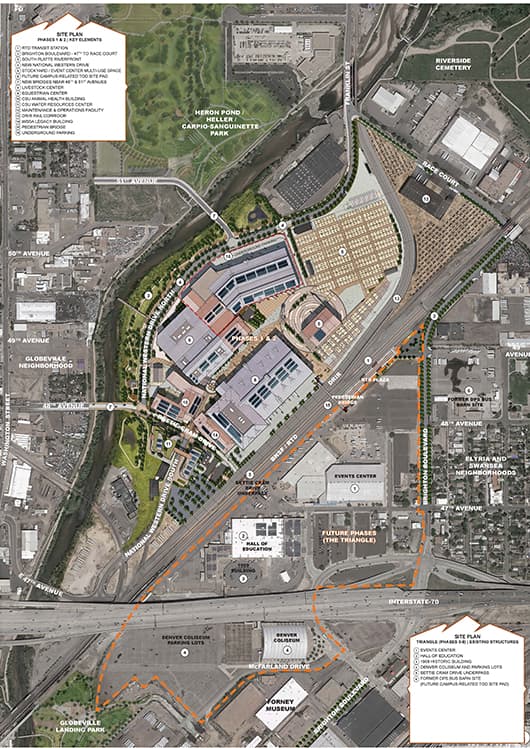The rodeo riders and mutton busters of the National Western Stock Show will one day trade the crusty confines of the Denver Coliseum for a gleaming new arena. The Hancock administration is digging in the deep pockets of the private sector to get it done.
Government types call these financing models public-private partnerships or P3s. The quick and dirty: When Denver's decision-makers want to do big things but lack public resources to do them now, they turn to companies backed by investors who front the money in exchange for long-term profit.
Here in Denver, P3s have been the rage for a while -- in both senses of the word. They're popular ways to get big things built (the Great Hall at Denver International Airport, RTD rail lines), but they also enrage people and cost money when they fail to deliver what was promised on time if at all (Denver International Airport, RTD rail lines). DIA's Great Hall project, which will cost the taxpayer-owned airport up to $210 million because of a P3 gone wrong, has caught the eye of city council members and Auditor Timothy O'Brien.
"Denver is growing, and capital construction is happening faster than ever, due to bond money and large projects like the National Western Complex and the Great Hall at the airport," O'Brien said in a statement. "We need to do everything we can to keep an eye on what the city pays for and what Denver taxpayers get in return."
Denver's latest attempt at a public-private partnership will put a major piece of the reimagined National Western Center campus in the hands of one of two consortiums over the next 30 years. The two teams of businesses are competing to finance, design, build and operate an exposition hall, the restoration of a 110-year-old building, and a new arena to host the National Western Stock Show and year-round music performances. Called the "Triangle" because of its shape, this part of the National Western Center is unfunded, unlike the rest of it, which was financed through a 2015 ballot measure.
Oh, and the private firms are also competing for a chance to build private development -- homes and business space -- on 42 acres of public land. That's compared to 18 acres of stuff that will serve the public.

According to city documents, the conglomerates and their investors would design, build and operate the venues, apartment buildings and commercial spaces. They'd front the money for the project and taxpayers would essentially pay them interest on that loan. It's worth it for them because they plan to make money from those taxpayer-funded interest payments and from running the various businesses after they're built.
Over 30 years, taxpayers will pay interest on the $528 million Triangle project, but at this point, Denver officials won't -- can't -- say how much because of ongoing negotiations. Even so, this public-private partnership is probably Denver's most transparent to date. That's just one wrinkle in the bedsheets that the couple will share.
The city government says the private companies can do a better job for cheaper. But it doesn't show its math.
To go after a P3 is for the government to admit that it's not up to the task. Sure, the public sector would get it done eventually, but officials say the private sector can deliver it faster with less stress on locals. And, officials say, they can deliver it for less.
"If you look at what construction inflation has done in the Denver area, every year that we wait because we don't have upfront cash, we can actually typically finance that money more cheaply, more cost-effectively, than waiting to build," said Josh Laipply, Denver's chief projects officer.
The Hancock administration estimates it will save taxpayers $12 million over 30 years by handing the Triangle to investors, according to an analysis meant to make the case for the P3 approach. The public route would cost more because of assumed delays, less efficient operations and deferred maintenance, according to the document, which cites multinational contracting firm Jacobs Engineering as its main source.


But the value for taxpayers is not crystal clear without the city showing how it came up with those figures, said Shahrzad Habibi, research and policy director for In the Public Interest, a watchdog group that studies P3s. She said the analysis does not seem rigorous, in comparison to other P3 agreements she has examined.
"It's unclear to me kind of where their assumptions came from and if they are reasonable assumptions or not," Habibi said. "They're not showing their math."
"Depending on the numbers you put in, it's very easy to kind of tip the scale," she added.
City government officials are not comfortable releasing its formulas publicly because it could skew proposals from Triangle Collective and Triangle Partners, the two groups comprising 19 firms that are chasing the job.
"For this project, the information in the published report is the level of detail we feel confident in releasing without compromising our internal financial analysis to the point that we essentially show the qualified proposers our internal calculations," said Julie Smith, spokeswoman for the Denver Department of Finance.
The city says it won't reveal how much taxpayers could be on the hook for because that would be bad for taxpayers.
Denverites will pay a chunk of the project's cost, but revealing what that ideal chunk is would give the city a leg-down in negotiating the contracts, according to Smith. In other words, if the companies knew how much the government wanted to pay, they could take advantage of it.
City Councilwoman Candi CdeBaca, whose district covers the Globeville and Elyria Swansea site of the campus, would like to see the city take a different approach: Go to the voters for the money, not private investors from around the world who don't have a stake in Denver's well-being.
"I appreciate the financing structure (the Hancock administration) pursued for the rest of the National Western Center because it was voter-approved financing," CdeBaca said. "And so they've been much more responsible with their reporting than I saw at DIA, and I think it's because of the voter-approved element.
"Instead they're just ramming this down our throat."
Hancock administration officials say the contract proposal is still a draft because they don't want to shove anything anywhere. It's malleable and will change according to public feedback, said Chris Pacheco, who heads Denver's Performance-Based Infrastructure Office.
"I think that's one of the benefits of going through this procurement process," Pacheco said. "We're trying to figure out ways to get these developers that can actually ask the community can weigh in on the site plan. "
Anyone can attend the first public meeting about this P3 agreement, on Jan. 25 at Swansea Recreation Center from 9:30 to 11 a.m.
Wait -- Denver is offering 42 acres of land to developers? Yes.
In The Public Interest's Habibi called the private development aspect "a little funky."
The winning bidder will have to pay for the land and for taxes after it's developed. The money -- we don't have an amount -- will offset costs to taxpayers, according to city documents.
And they'll have to make 20 percent of any new condos or apartments "affordable" according to Denver's average income, the draft proposal states.


"I think it seems like the city is trying to do the right thing there," said Habibi with In the Public Interest. "But are these (features) going to stay in subsequent draft proposals? I think that something you need to look out for."
The city's Pacheco said the draft RFP's wiggle room lets the city get better concessions from the private sector. CdeBaca sees it as wiggle room for developers to water down community benefits and increase profits.
"We're starting off the project by telling them to tell us what we need," CdeBaca said.
She wants to see a hard number of mandated homes. After all, she said, what's 20 percent of nothing?
This P3 attempt seems to be Denver's most transparent to date. And the private companies clearly take on risk.
The National Western P3 is the first to go through an office built solely to analyze and streamline these agreements.
For example, the office released a draft request for proposals for the public to review. That's rare. The RFP can change with public input -- also rare.
Laiply of the Hancock administration said P3s might have a bad rap because they tended to favor developers in the past, but that the Triangle project represents a push-back.
"The industry in general is starting to figure out where the line is," Laiply said. "I think it's been too far drawn on one side of the aisle, which is, 'We don't want to disclose anything because it's proprietary.' We're pushing that line further and further back to where I think the only things that will really end up being confidential is their financing plan."
The companies and their investors -- not taxpayers -- take on risk, even if it's calculated. They will be responsible for maintenance, for example, an early casualty of any economic downturn. They'll own the venues and other buildings that house apartments, offices and restaurants, meaning they're at the whim of the local economy.
Predicting what the market will do over the next 30 years is a difficult proposition -- one of the many what-ifs that made Habibi call pinning down the value of P3s "more of an art than a science."













